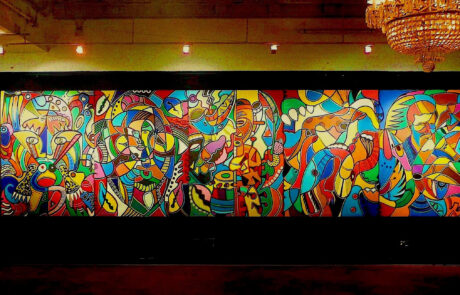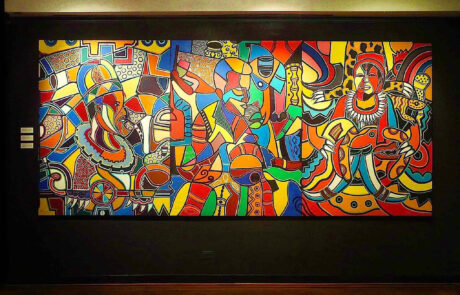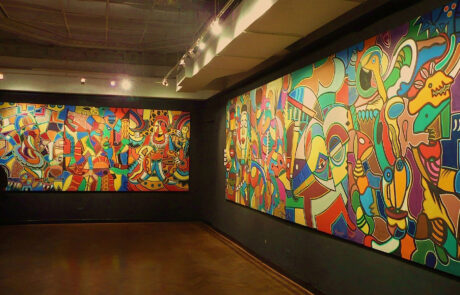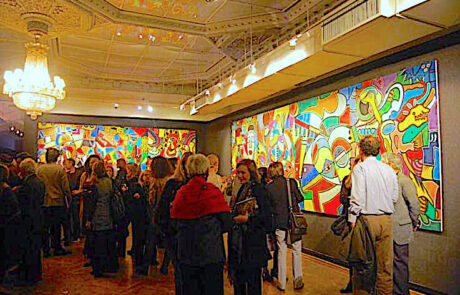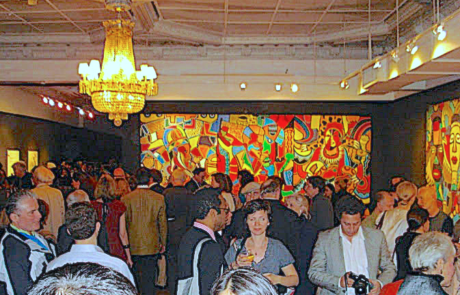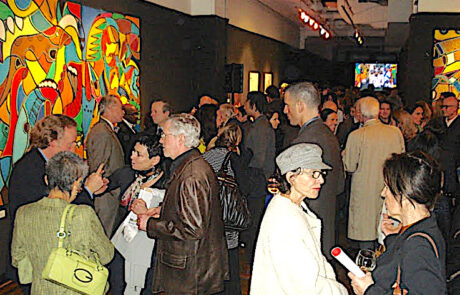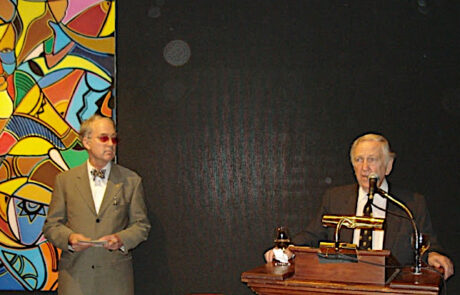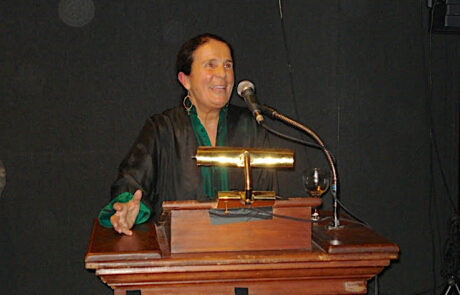The EPPP has a unique role in both the city of Brazzaville and the Republic of Congo. The creative inspiration that we are blessed with is a natural gift from God. One of our proverbs says: “Whoever denigrates art, denigrates nature.” In order to help the viewer understand this painting (6.5 x 60 feet), we hereby present the spirits that have guided our thoughts and our hands:
THE PANTHER – by Pierre Claver Ngampio
In the Batéké kingdom the panther is a synonym for power, strength, quick intelligence, intuition about danger. The color of its mantle is deliberately used by the dignitaries of the royal court as a symbol for mystery and invisibility. The panther’s appearance in nature is a forewarning.
THE BEMBE MARRIAGE – by Gerly Mbo
In the region of Bueza, among the Bembé tribe, the future groom must capture a wild pig. To pass the test and impress his future in-laws, he must show courage, patience and decisiveness. The wedding feast must include the cooked animal prepared with banana in a succulent dish called Ngulu mu mako. This is an essential sign of good luck for the future couple.
NKUYU WA YUMA, THE LITTLE STATUE WITH NAILS – by Romaine Mayoulou
This statue, with nails and a small mirror on the abdomen, is an object of worship. It is synonymous with suffering and mystical power. It is used in various initiation and exorcism ceremonies, particularly in the southern area of the Pool, along the Congo River.
SERGEANT MALAMINE – by Jacques Iloki
The Senegalese Malamine is a crucial figure in the history of Congo and the life of the explorer Pietro di Brazzà. He came as a brother to our lands and is remembered with great fondness as an African hero.
PIETRO DI BRAZZA – by Gerly Mpo
The Italian-born founder of our city is indissolubly linked to our country. He signed an alliance with Makoko Iloo I in September 1880. Our city, Brazzaville, is the only African capital that has not changed its name after independence.
ILOO I, BATEKE SOVEREIGN – by Pierre Claver Ngampio with Leticia Mahoungou and Vanessa Agnagna.
Makoko Iloo I represents order and peace. He embodies the all-powerful divinity, Nkwé Mbali. During important occasions, he wears the emblematic engraved bronze necklace, and the vivid red-colored parrot feather. Usually, Makoko wears a necklace made of panther teeth, symbol of the sacred power of the kingdom’s dignitaries.
PIERRE LODS – by Sylvester Mangouandza
The founder of the EPPP left an enormous legacy to Congo. After over fifty years, the school is still a point of reference in the country. His first pupils were Osali, Ondongo, Elenga and Iloki.
NGUIA, THE KING’S HEALER – by Serge Dzon
He is a personality of great importance for both the Batéké Gangolu and the Mbochis people. He is the holy man who embodies the traditional power of mysticism. The strong colors applied on his face reflect his great power and the split-personality revealed in his serene glance.
KEBE-KEBE MASKS – by Adam Opou
In general, the mask in Congo is accompanied by ritual chanting during all main rites of passage, such as birth, marriage and death. The Batéké who live along the Alima River, the Mbochis and the Kuyu adore these highly colored masks, decorated with the feathers of various birds. During the initiation ceremonies, the male masked-dancer must be pure in spirit in order to be attuned to these fetishes.
BAKUELE MASK – by Sylvester Mangouandza
Among the Bakouelé and the Bakotas (Mbanba), this mask is sacred. Whoever wears it must have been initiated to avoid the anger of the fetish. It is used in the Sangha and Lekumu regions during numerous ceremonies and rituals in the life of the communities.
THE NZOBI FETISH – by Adam Opou
The Nzobi is popular in the regions of Lekumu and western Cuvette. A spiritual guide is mandatory to enter into symbiosis with this fetish, which requires great sacrifices in exchange for its highly potent protection. The Nzobi is deeply feared by the Batéké Mbamba, Mbtis, Mboko and Ngaré peoples.
THE LOKOLE – by Bokouloumba
A traditional musical instrument used in the regions of Likuala, Bueza and Sangha regions. This hollowed piece of wood engraved on the outside, is used to transmit various messages by the Bmitabas, Balloys and Djombo ethnic groups. The lokolé is codified and requires apprenticeship before it can be played during public ceremonies.



